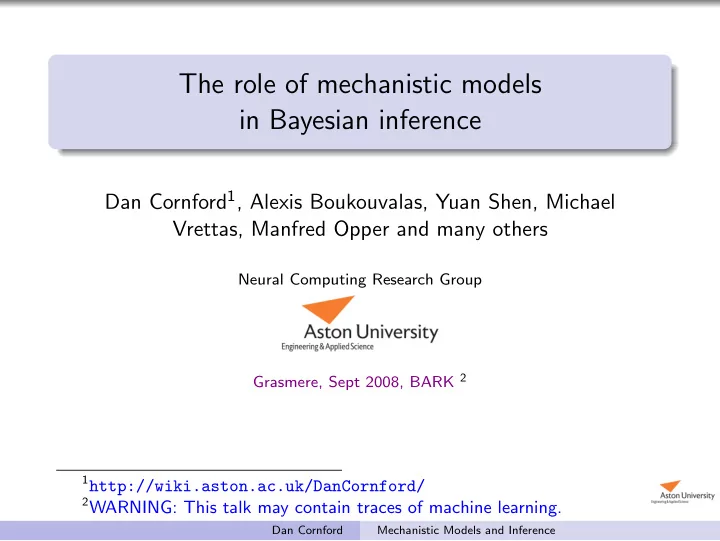

The role of mechanistic models in Bayesian inference Dan Cornford 1 , Alexis Boukouvalas, Yuan Shen, Michael Vrettas, Manfred Opper and many others Neural Computing Research Group Grasmere, Sept 2008, BARK 2 1 http://wiki.aston.ac.uk/DanCornford/ 2 WARNING: This talk may contain traces of machine learning. Dan Cornford Mechanistic Models and Inference
I am interested in problems in the ‘real world’ weather forecasting - will it rain tomorrow? climate - should I really move to higher ground? disease modelling - will rabies become established in Finland? environmental monitoring - is it safe to eat those mushrooms? These are in essence difficult regression (decision) problems – where prior knowledge is key. Prior knowledge is often in the form of physical laws, typically implemented as simulators. Dan Cornford Mechanistic Models and Inference
Here is my naive view of the problem. Dan Cornford Mechanistic Models and Inference
Simulators and modelling In the physical and natural sciences the emphasis has been on laws, processes and mechanisms. These are combined in complex models, which I will call simulators, almost always implemented as computer code. Historically these models were deterministic – a given input produces a given output. Climate models are great examples – vastly complex, running on the largest computers in the world, and barely using data! So how do these (deterministic) models fit in a Bayesian framework? Dan Cornford Mechanistic Models and Inference
Simulators and modelling In the physical and natural sciences the emphasis has been on laws, processes and mechanisms. These are combined in complex models, which I will call simulators, almost always implemented as computer code. Historically these models were deterministic – a given input produces a given output. Climate models are great examples – vastly complex, running on the largest computers in the world, and barely using data! So how do these (deterministic) models fit in a Bayesian framework? That’s the topic of this talk. (And the next N years of my life!) Dan Cornford Mechanistic Models and Inference
Dan Cornford Mechanistic Models and Inference
How can we use deterministic simulators? Throwing them out is wasteful These models encode prior knowledge from many sources – we need to use this – especially in extrapolation situations. Uncertainty analysis, sensitivity analysis: What is the impact of uncertainties in inputs on outputs? Assuming we can define distributions over the relevant inputs (elicitation), sample from these and use Monte Carlo methods. Analysis of the simulator - no use of data here! One problem is that (interesting) simulators are very expensive to run. A solution is to emulate the computer code, using e.g. a Gaussian process. Dan Cornford Mechanistic Models and Inference
MUCM: Managing Uncertainty in Complex Models Dan Cornford Mechanistic Models and Inference
MUCM: Managing Uncertainty in Complex Models RCUK Basic Technology Project: Extend emulation to: high dimensional models, dynamic simulators, calibration, linking models to reality, improved designs. Make these methods accessible to applications. This area has many open challenges; we are investigating: emulation of stochastic models, often with non-Gaussian output distributions. emulation of high dimensional models, using dimension reduction. Dan Cornford Mechanistic Models and Inference
Stochastic simulators To make further progress: Simulators must become stochastic – randomness arises from incomplete knowledge, not internally. Model error is critical to represent; simulators then define (complex) priors. The problem now is how to do inference with such complex priors. Full Monte Carlo (or MCMC) is not conceivable – these process based models are often very high dimensional, being based on partial / ordinary differential equations. So can we approximate somehow? Emulation remains an option. Dan Cornford Mechanistic Models and Inference
VISDEM: Variational Inference in Stochastic Dynamic Models Dan Cornford Mechanistic Models and Inference
Summary Machine learning has shown that really difficult problems can be tackled and solved. A range of novel approximate inference methods, particularly variational methods have been developed. These could be applied to process driven models if we characterise the model errors, and emulation is an option too, with appropriate relation of the model to reality. The overall Bayesian framework stays the same, but the prior is more complex. Lots of unresolved issues with implementation – size / speed, optimisation, exploiting structure, and more. But if we can do it, we can use data and extrapolate well. Dan Cornford Mechanistic Models and Inference
Recommend
More recommend